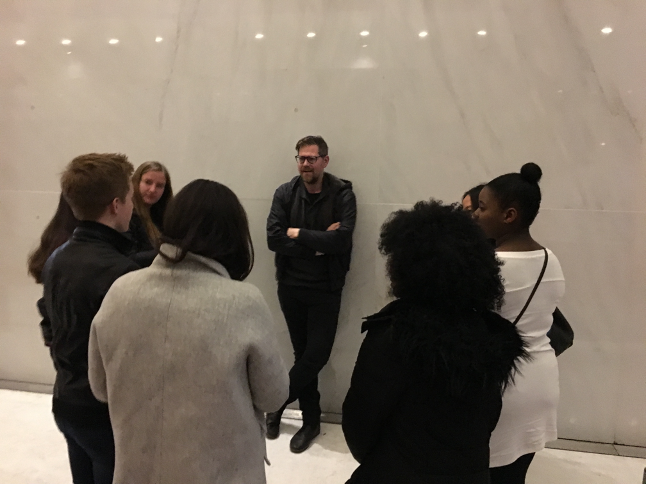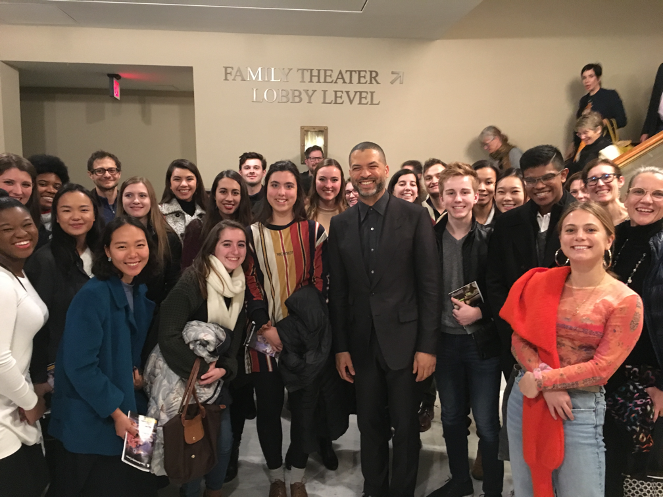Interdisciplinary Humanities Pedagogy: HALC Faculty Fellows Create New Courses to Meet Demand
Meet Professor Ian Bourland

The Humanities, Arts, Literature, and Culture (HALC) “Faculty Fellows Cohort” connects six distinct HALC courses via common experiences, common work, cross-section presentations and discussions, and a symposium featuring examples of student learning through courses that introduce the cultural humanities.
Art History Professor Ian Bourland, who participated in the project, designed aspects of his ARTH-353 “Exiles and Diasporas” course to explore the learning goals and recommendations that emerged from the discussion of the Faculty Fellows and the HALC Committee—project-based creative work; connections with DC cultural and humanities institutions; and engagement with the ethical implications of culture. He shared the following reflection about his experience.
I am an Assistant Professor in the Department of Art and Art History and a cultural critic who writes and teaches about postcolonialism, the Black Atlantic, and the global contemporary. When I joined the College a few years ago, I noticed the range of attributes associated with courses on the schedule. I did not initially know what HALC meant. But as someone committed to both interdisciplinary approaches to the humanities, and to the humanities as crucial to the formation of all of our students, I wanted to know more. During the 2019-2020 Academic Year, I joined a cohort of colleagues from across the College as a HALC Faculty Fellow.
The cohort experience provided me the opportunity to develop and workshop a new HALC course from the ground up (and, importantly, to do so before the considerations imposed by the pandemic). The result, “Exiles and Diasporas” was, by design, interdisciplinary and transnational in its inquiry. The context of the Fellows encouraged me to both start “from the drawing board” with the HALC requirement in mind, and to include collaborative and creative modes of assessment.
While history remained a primary lens in the course, I decided not to teach art historical methods or “canonical histories” but, rather, to question my own previous approaches and those of my discipline in general. Ultimately, my goal was to use case studies and concepts from my field as a jumping off point into larger humanistic debates crucial to forging culturally, ethically, and politically attuned Georgetown graduates. My subfield lent itself to such conversations, but the Fellows program empowered me to go further, to think of my learning outcomes less from the silo of the curriculum, and more as an ongoing and open-ended conversation centered on pressing contemporary matters of race and structural racism, the ways in which historical systems of power are inscribed into the cultural and urban landscape, and the nature of citizenship and representation during a time in which immigration is at the center of our national discourse.
The most helpful aspect of the HALC Faculty Fellows program was, for me, the ways in which it pushed me to rethink assessment in the classroom, and the possibilities for a more public-facing pedagogy. Rather than midterms and term papers, I required students to undertake an array of shorter assignments, varying in tone and emphasis. Sometimes this meant using personal reflection or creative work (drawing and sketching) as means of reflection; at other times it meant synthesizing theory with site visits. At all times it meant connecting students’ life experience to that of larger communities. I required students to go beyond the bubble of the Hilltop and explore neighborhoods around the region, to meet people, to go to museums and consult archives. A highpoint all around was a shared visit by several classes to a Jason Moran (celebrated visual artist and jazz musician) concert at the Kennedy Center, followed by small group conversations that blended the various sections in attendance.
I recognize that it is, perhaps, a big ask to encourage colleagues to rebuild an entire course to meet the learning goals of the Core HALC requirement. I benefited from the framework of a dedicated cohort. I think that both my students and I learned a great deal, and I plan to integrate aspects of my HALC course into my teaching more broadly. For instance, I will seek out colleagues in other Departments in the semesters ahead to coordinate shared texts or events in DC that may be of mutual interest; I will include more “low stakes” assignments designed less around command of disciplinary convention and more about using the lens of art history to connect students with the world around them, and as a means of posing ethical and methodological questions—in particular, that students will “develop generative habits of mind for a world in flux: openness, resilience, curiosity, creativity, imagination”. Ultimately, I’ll remember that the creative humanities are a conversation happening all around our campus and not just in my classroom, that there are ways of knowing that can be brought into productive relation.
I think everyone in the humanities can look at this pilot program and remember that one of the privileges of working at Georgetown University is that our brief is not just sharing knowledge but, indeed, cura personalis, the cultivation of balanced, multifaceted students who thoughtfully engage with communities large and small. These are ideals that we strive for, to be sure. On a personal note, my Exiles and Diasporas course was in many ways the most challenging semester of teaching in recent memory, but it was also the most rewarding and enjoyable.
